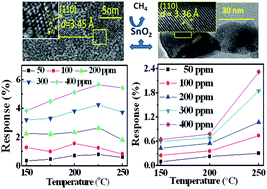The role of SnO2 quantum dots in improved CH4 sensing at low temperature
Abstract
The role of quantum dots (QDs) of SnO2 in detecting low concentrations of methane (CH4) at a relatively low temperature of ∼150 °C with high response (S ∼ 3.5%) and response time below 1 min is reported. A simple room temperature single step chemical process was adopted for the growth of SnO2 nanoparticles of a size around 2.4 nm. These nanoparticles were subsequently annealed at 800 °C to increase the grain size to 25 nm. The as-prepared SnO2 nanoparticles, being smaller than the corresponding Bohr radius (2.7 nm), showed a strong quantum confinement effect with a blue shift in the band gap energy from 3.6 eV for the bulk SnO2 to 4.37 eV for the QDs. These QDs exhibited a strong sensing response to CH4 in comparison to the annealed sample. A low activation energy of 90 meV, as estimated from the temperature dependent S plot for SnO2 QDs, was found to be the driving force for such unusual high sensitivity at a low operating temperature. X-ray diffraction, transmission electron microscopy, along with Raman spectroscopy measurements are used for the detailed structural studies. The critical role of the chemisorbed oxygen species present at different operating temperatures on the surface of the off-stoichiometric quantum sized SnO2 and bulk-like annealed samples are discussed in light of the adsorption kinetics.


 Please wait while we load your content...
Please wait while we load your content...